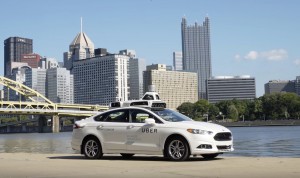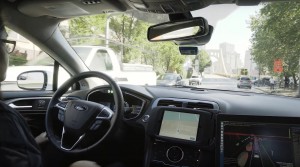
Uber unleashed its fleet of autonomous Ford Fusions on the city today, hoping to gain valuable real-world data.
The Steel City is now home to what may be the most technologically advanced ride-sharing fleet in the U.S. courtesy of Uber.
The ride-sharing company began testing a small fleet of autonomous Ford Fusions today, picking up Uber users who opted into a test program. The cars are fully autonomous, although an Uber engineer sits in the driver’s seat to take control if something goes wrong.
The competition among ride-sharing companies is heating up. NuTonomy beat Uber to the punch on a worldwide level last month in Singapore when it began picking up passengers in self-driving taxis. The company said Tuesday that its six taxis — with backup drivers — haven’t had any accidents since the service launched.
Uber is the first service in the U.S. offering driverless rides.
(Uber, Volvo team up for free autonomous rides. Click Here for the story.)

Pittsburgh is the "double black diamond" of testing locations due to its complex series of roads, terrains and bridges.
“That pilot really pushes the ball forward for us,” Raffi Krikorian, director of Uber Advanced Technologies Center (ATC) in Pittsburgh, told the Associated Press. “We think it can help with congestion, we think it can make transportation cheaper and more accessible for the vast majority of people.”
The Uber vehicles are equipped with the usual array of cameras, radar sensors that detects 20 LIDAR “pucks” providing a 3D view around the car.
Seeing a car laden with cameras and LIDAR “pucks” isn’t as unusual as it once was as the competition to be first to market with a reliable self-driving is getting more crowded. Google was the early standard bearer, but more and more automakers, suppliers and tech companies are elbowing their way into the arena.
Competitors such as Ford, General Motors, Volvo and Delphi, among others, have invested hundreds of millions of dollars and logged millions of miles test driving autonomous vehicles, into the development of autonomous vehicles.
(Click Here for details about Uber’s testing of autonomous vehicles.)
Uber picked Pittsburgh to test its fleet because the city features a variety of conditions and issues that driverless cars need to be able to handle, such as snow, changing terrain and a complex network of roads and bridges.

For now, Uber specially trained engineers sit behind the wheel of every autonomous Uber in Pittsburgh.
“We actually think of Pittsburgh as the double black diamond of driving,” Krikorian said to AP. “If we can really tackle Pittsburgh, that we have a better chance of tackling most other cities around the world.”
There’s also a practicality to it on the legal level: the state doesn’t have any laws on the books yet about autonomous vehicles. All of the testing is perfectly legal, Uber claims, and by having a fleet of vehicles toiling about in the city, company officials hope to shape future legislation regarding testing and, ultimately, the daily use of autonomous vehicles.
Uber is hoping to reduce fears about the impact of driverless cars on society through this type of testing as well. Real-world testing is critical to the success of this technology, the company notes, adding that creating a viable alternative to individual car ownership is important to the future of cities.
(“Nu” autonomous taxi service in Singapore beats Uber to the punch. For more, Click Here.)
“Of course, we can’t predict exactly what the future will hold,” the company wrote in a blog post about the program. “But we know that self-driving Ubers have enormous potential to further our mission and improve society: reducing the number of traffic accidents, which today kill 1.3 million people a year; freeing up the 20% of space in cities currently used to park the world’s billion plus cars; and cutting congestion, which wastes trillions of hours every year.”
